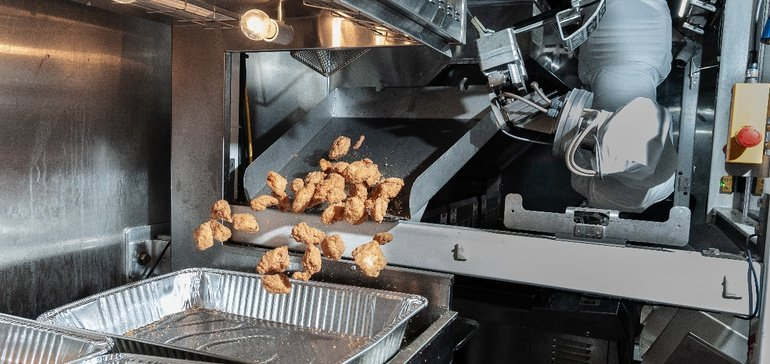
Rise of the robots: How restaurants can automate without losing the human touch
Robots seem to be everywhere these days, at least in the restaurant business. A week doesn’t go by without industry trades and mainstream press bringing us headlines like “Robots take over major casual dining chains.”
Robots are flipping burgers and frying chicken wings, and driverless bots and drones are delivering meals to hungry customers. No wonder those headlines include words like “take over” — at this rate, it’s starting to feel as if androids will replace all of us pretty soon.
That might be a welcome development for many restaurant operators — especially those feeling the effects of an ongoing labor crunch. Last year, the U.S. Bureau of Labor Statistics reported that the quit rate among hospitality workers had reached 6.6% per month, more than double the national average. What’s more, full-service restaurants are operating with 6.2 fewer kitchen employees than they were in 2019.
Technological solutions that ease labor pressure by automating certain processes have become essential tools, and that automation tends to have artificial intelligence as its basis. According to one recent report, 50% of U.S. restaurant operators are planning to implement some form of automation technology in the next two to three years.
While we’re crunching numbers: at the global level, the AI market is projected to grow to a value of $190.61 billion by 2025, while the food tech market will reach an estimated $342 billion by 2027. Artificial intelligence has already made serious inroads into a number of aspects of the foodservice industry.
Over the past two years, we have seen all sorts of alarming statistics indicating that large numbers of former hospitality workers have no intention of returning to their old gigs. However, there are still plenty of people who intend to remain in the industry. Instead of adopting new technology with the aim of replacing human beings, employers would be better off embracing those digital tools that can make these jobs more satisfying by increasing efficiencies in every area of a restaurant’s operations.
This doesn’t mean everything is going to be done by technology, of course. We’re not likely to wake up tomorrow to a world in which restaurants are fully staffed by gleaming metal servers like something out of “The Jetsons.” Yes, the use of automation is increasing, but it’s no substitute for human service, both at the front of house and in the kitchen and back office. Consumers still prefer the human touch of an experience that is personalized and relevant to them, but they also appreciate the efficiencies that robotics can deliver, such as improved hygiene and prompt service.
Identify where automation can help
To determine where automation might be helpful in their business, restaurant operators need to take a good look at their current tech stack and assess whether or not it is meeting their needs in key areas.
- Is it bringing consumers through the door — or to your app or website — through personalized offers and loyalty-based engagement?
- Does it employ machine learning-based algorithms to predict order wait times based on capacity and demand?
- Is it delivering analytics and providing actionable insights, like which items sell best at certain times of day?
- Does it connect the back office and kitchen operations with the consumer-facing front of house to create a unified commerce experience that benefits operators and customers alike?
If the answer to the above questions is no, it may be time to embrace the future and start incorporating more AI and automation into your operation.
Consider the most pressing needs
To determine what technology to implement, restaurant operators need to consider what their most pressing needs are. If, for example, you have a quick-service or fast casual restaurant and are looking to speed up the order-taking process, you might find point-of-sale tablets to be a game-changer. POS tablets allow QSRs to keep lines moving during peak hours, even with fewer staff members working. The tech isn’t replacing people, it’s simply making what they do easier and more efficient. Tablets can relieve bottlenecks by keeping the flow of orders moving, thus giving the kitchen the chance to stay ahead of possible backups.
Let’s say, on the other hand, that your concern is enabling managers to spend more meaningful time building relationships with customers and less time stuck behind a desk doing administrative work. Consider the possibilities that could be opened up by investing in a mobile back-office system that can be accessed on any device, putting the right data in the right hands at the right time.
And data, to be sure, is king. One of the lasting effects of the COVID-19 pandemic on the industry is that it caused restaurants to give greater weight to the information they collect and apply to their operations. That information — derived from a number of sources, including POS, back-office platforms and cloud-based solutions — enables restaurants to improve efficiencies, thus making life a little easier for their remaining staff….[Read more at: https://www.restaurantdive.com/news/rise-of-the-robots-how-restaurants-can-automate-without-losing-the-human-t/617703/]

